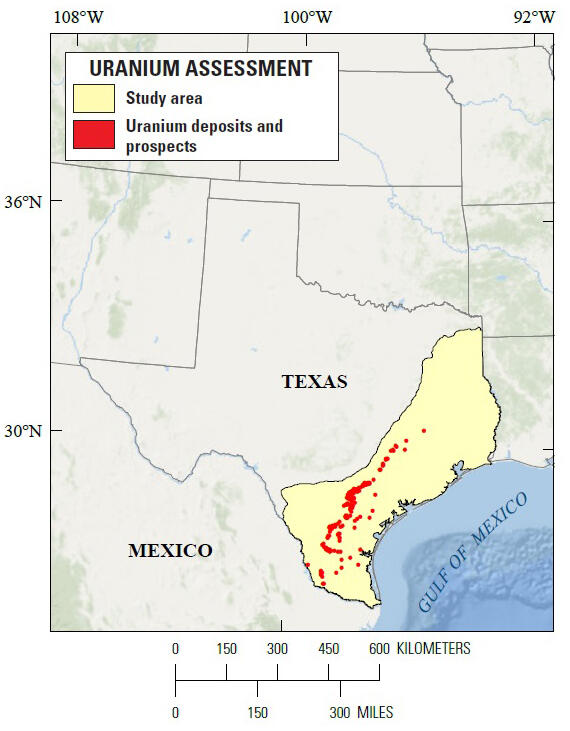Estimates of Potential Uranium in South Texas Could Equal Five Years of U.S. Needs
The uranium oxide is located in sandstone formations throughout the South Texas Coastal Plain, which borders the Gulf of Mexico. The area has long been known to contain uranium, and two mines are currently in operation, with a number of companies actively exploring for uranium.
DENVER, CO. — The potential for almost five years of annual domestic U.S. nuclear fuel requirements may exist in south Texas, according to a new USGS assessment of both identified and undiscovered uranium oxide resources. This assessment estimates 60 million pounds of identified, but unmined, uranium resources, and more than 200 million pounds of newly estimated undiscovered resources.
The uranium oxide is located in sandstone formations throughout the South Texas Coastal Plain, which borders the Gulf of Mexico. The area has long been known to contain uranium, and two mines are currently in operation, with a number of companies actively exploring for uranium.
“As the world’s leader in nuclear power, uranium is both a critically and strategically important resource,” said Larry Meinert, program coordinator of the USGS Mineral Resources Program. “Identifying and understanding our domestic mineral wealth is a vital part of ensuring the security of our supply chain for these resources.”
The 60 million pounds of identified uranium resources could, if mined, provide up to one year’s worth of domestic nuclear fuel requirements, based on 2014 requirements. The 200 million pounds of undiscovered resources could, if proven and produced, add another four years of nuclear fuel for the United States, bringing the total potential to about five years of domestic supply.
U.S. nuclear power plants generate about 19 percent of the Nation’s electricity. In 2014 alone, these plants purchased 53 million pounds of uranium oxide to meet their needs, and U.S. nuclear capacity is expected to increase.
The United States has more nuclear plants than any other country, but imports more than 90 percent of the uranium used in those plants.
“This study highlights the breadth of USGS science related to complex issues associated with the mineral and energy resources lifecycle,” said Jon Kolak, acting program coordinator for the USGS Energy Resources Program. “The USGS provides impartial information to help resource managers, policymakers, the public, and others balance the need for adequate and reliable mineral and energy supplies against the potential effects of resource development and use on the landscape.”
This new study is part of a larger USGS effort to update knowledge of the geologic setting, occurrence, and amount of the Nation’s uranium resources.
The USGS collaborated with the Texas Bureau of Economic Geology on the South Texas assessment. Nuclear power requirements and electricity production are tabulated by the U.S. Energy Information Administration.
A fact sheet describing this assessment is online. The USGS provides both energy resource assessments and mineral resource assessments. To stay up to date on all of our energy and mineral resources research, follow us here:


